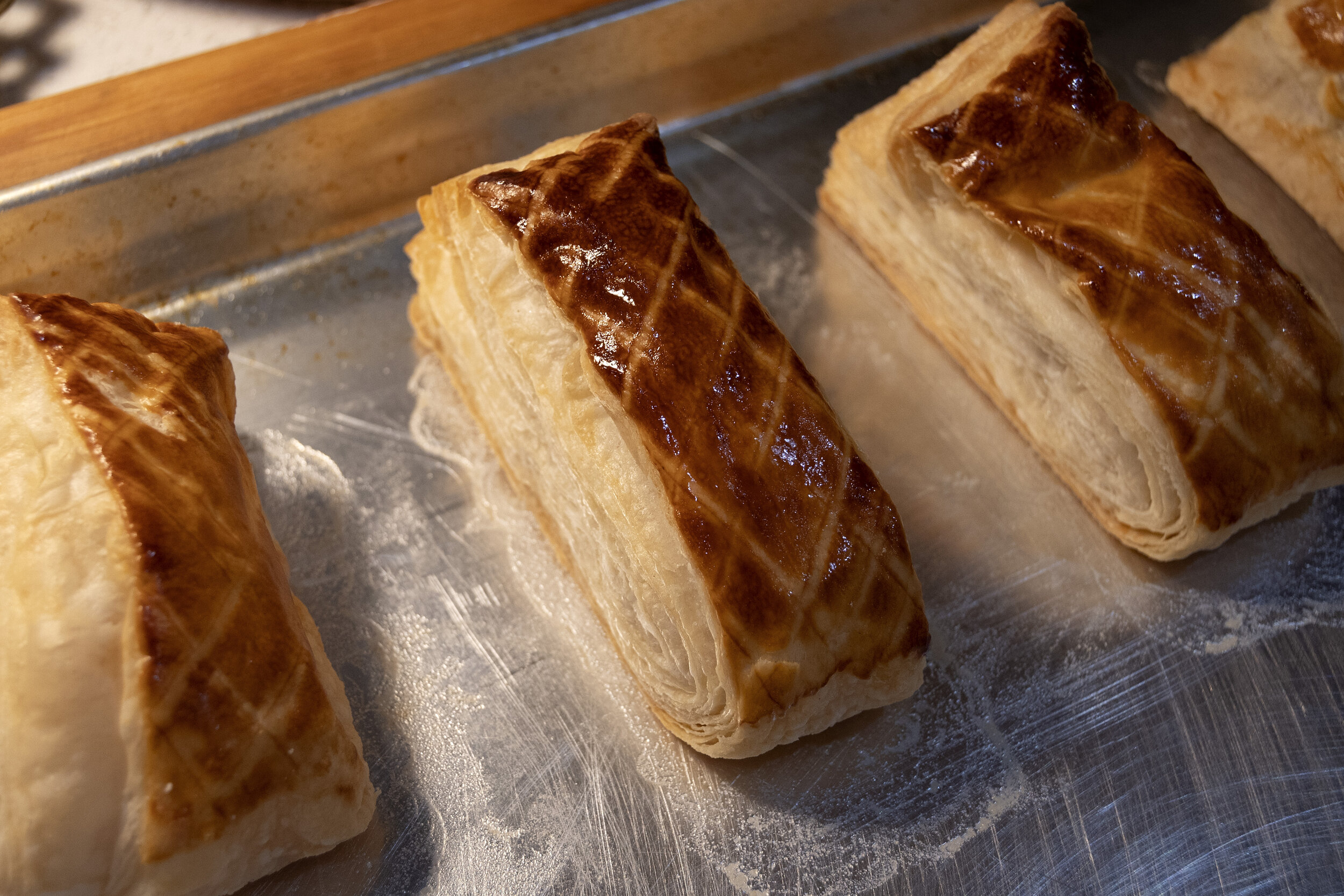Puff Pastry Rectangles
[Photo credit: Alex Paternostro]
by Seth Paternostro
October 13, 2021
Marshall Fields is dead, yet memories of the fabled department store’s basement cafeteria live on. Dappy after a stroll through the “fragrance destination,” weary from hiking the escalators, and ready to reset, an order of chicken à la king and puff pastry always made the trip with my mother worthwhile.
Crisp and fabulous on its own, puff pastry is a pain to make. But it’s worth it...While the traditional method often includes only the most basic ingredients—flour, butter, water, and salt—a dash of vinegar and a pinch of sugar lend balance. With an air conditioner and refrigerator, 1458 layers of buttered beauty are only a few folds away.
Makes 12 pastries
Total time
4 hours 30 minutes
Equipment:
measuring cups and spoons, mixing bowls, knife, bench scraper, rolling pin, baking sheet, digital scale, plastic wrap, 2 pastry brushes, small bowl, fork, aluminum foil (if needed)
Tableware:
plates and utensils
Ingredients
220 grams all-purpose flour, chilled, plus as needed for dusting
252 grams unsalted butter (2 sticks, plus 2 tbsps), cold
½ cup ice cold water, or as needed
2 tsps white wine vinegar
5 grams fine sea salt (about ¾ tsp)
2 grams sugar (½ tsp)
1 egg yolk
1 tbsp milk
Instructions
Set out all equipment and ingredients. Cut 2 large pieces of plastic wrap.
Mix 200 grams flour, 4 grams salt, and 2 grams sugar until homogeneous.
Cube 26 grams (2 tbsps) butter, and mix into the flour with your hands until the consistency of fine bread crumbs.
Dig a hole into the center of the flour, add the water and 1 tsp white wine vinegar, then gently push the flour mixture into the liquids. Mix by hand until the dough comes together into a ball.
Cover with plastic wrap, shape into a square, and refrigerate for at least ½ hour.
Meanwhile, cube the rest of the butter (224 grams), then combine with 1 gram salt, 1 tsp white wine vinegar, and 20 grams flour.
Quickly work the butter mixture with your hands until the flour is evenly distributed throughout. Stop if the butter begins melting too fast.
Place the butter on the plastic wrap, cover completely, then roughly shape into a square. Refrigerate for at least ½ hour.
Dust the counter and rolling pin with flour.
When the flour and butter squares are cool, roll the flour dough into a square about twice as large as the butter block.
Place the butter block on top of the dough, and rotate the butter block so that its corners touch the midpoints of the dough’s sides.
Fold the dough triangles over the butter block, and pinch the edges together, fully encasing the butter in the dough.
Roll into a ½ inch thick rectangle, then fold the left and right thirds over the center, like an envelope.
Cover in plastic wrap, and place in the refrigerator for ½ hour.
With the long side of the rectangle parallel to your rolling pin, roll ½ inch thick, brush any flour off the top, then fold like an envelope. Chill covered for ½ hour.
Repeat the rolling, folding, and chilling 4 more times.
Preheat the oven to 400°F with a rack in the upper third.
Beat the egg yolk and milk together in a small bowl with a pinch of salt.
Roll the dough into a ½ inch thick rectangle, sweep any loose flour from the top, then brush with the egg wash, taking care not to drip any down the edges.
Chill uncovered on a baking sheet for 10 minutes.
Brush again with the egg wash, and chill uncovered for another 10 minutes.
Using a bench scraper or the back of a knife, gently impress diagonal lines ½ inch apart into the egg wash coating, then rotate the bench scraper to form a diamond pattern.
Cut the dough with a sharp knife into 12 rectangles, space the pieces out on a baking sheet, then refrigerate for 10 minutes.
Bake the pastries for 10 minutes, turn the heat down to 375°F, then cook for another 20 minutes. If the tops begin turning too dark, then cover the pastries lightly with aluminum foil.
Enjoy with cream of mushroom soup, cherry jam, or on their own.
Note: For puff pastry to attain its signature lightness, its butter must be cold. In a state not shatteringly chilled but hard enough to flatten without melting, the butter is key to lifting and crisping 2*3^6 layers of dough.
[Photo credit: Alex Paternostro]
NUTRITION FACTS:
Calories 223 Total Fat 17.6g (55%) Saturated Fat 11g (55%) Cholesterol 63mg (21%) Sodium 287mg (12%) Total Carbohydrate 14.3g (5%) Dietary Fiber 0.5g (2%) Total Sugars 0.3g Protein 2.3g Vitamin D 13mcg (66%) Calcium 11mg (1%) Iron 1mg (5%) Potassium 28mg (1%) - Note: Please read our Nutrition Disclaimer.
[Photo credit: Alex Paternostro]
Seth Paternostro is a writer and recipe developer based in Chicago. He is a co-founder of Our American Cuisine and graduated summa cum laude from Princeton University with an A.B. in East Asian Studies. You can learn more about him here.
Cooked the dish? Please share it with friends!
Tag us on Instagram @ouramericancuisine, join our mailing list, and follow us on social media for more of our favorite recipes, essays, and more!


